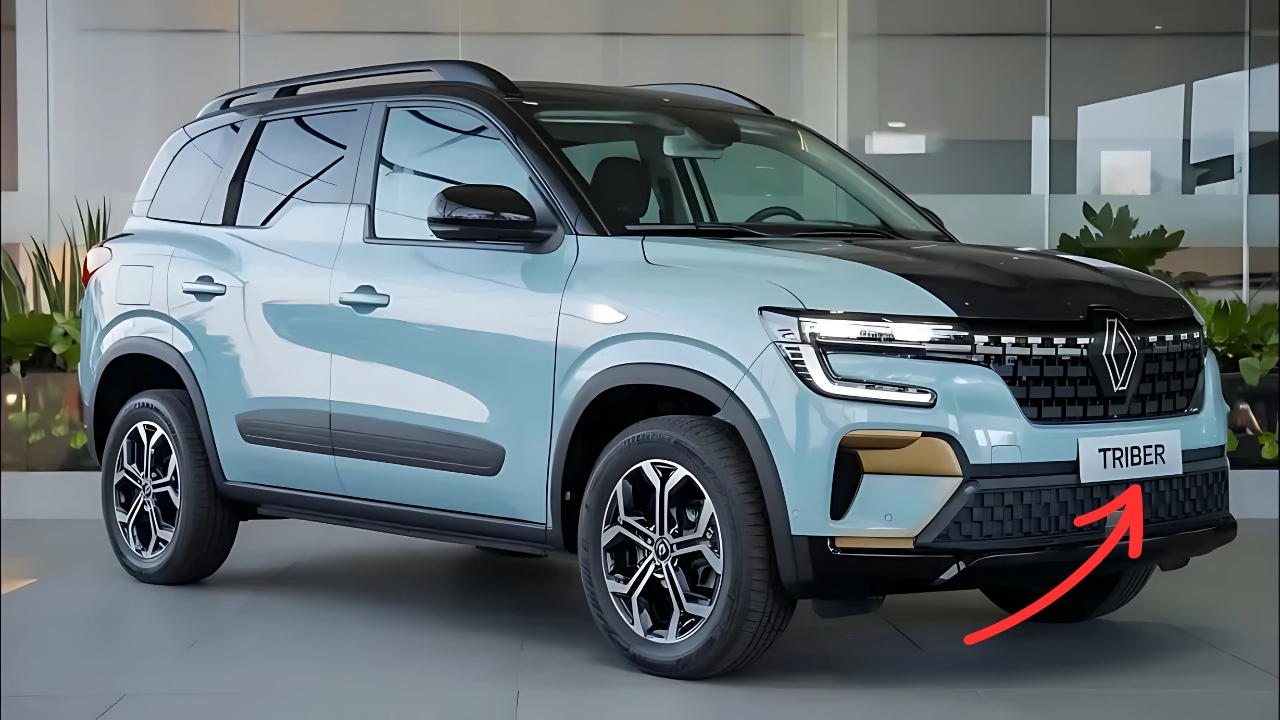Renault Triber: In the competitive landscape of the Indian automobile market, where value-for-money propositions often take precedence over luxury offerings, Renault has carved a unique niche with its innovative Triber.
Launched as an affordable 7-seater vehicle that defies conventional categorization, the Triber represents Renault’s understanding of the evolving needs of Indian families seeking spacious, versatile transportation without breaking the bank.
Renault Triber: Design Philosophy: Maximizing Space Within Compact Dimensions
The most remarkable achievement of the Renault Triber lies in its clever packaging. Measuring just under four meters in length (3,990mm), the Triber qualifies for lower taxation in the Indian market while offering seating for seven occupants—a combination previously thought impractical, if not impossible.
This engineering feat begins with the CMF-A+ platform, shared with the Kwid but extensively modified to accommodate the Triber’s more ambitious spatial requirements.
Visually, the Triber presents a balanced design that avoids the awkward proportions sometimes associated with compact three-row vehicles.
The front fascia features Renault’s signature design elements, including a prominent chrome-studded grille flanked by projector headlamps with LED daytime running lights.
The sculpted bonnet and defined character lines along the sides lend the vehicle a certain dynamism despite its utilitarian purpose.
The SUV-inspired styling elements, including roof rails, skid plates, and 15-inch alloy wheels, contribute to a robust appearance that aligns with current market preferences.
Ground clearance of 182mm further enhances its capability to tackle varying road conditions, an important consideration for Indian buyers who often face challenging infrastructure.
Perhaps most impressive is how Renault’s designers have managed to create a vehicle that doesn’t immediately broadcast its budget-friendly nature.
The proportions are well-balanced, the overhangs are minimal, and the overall silhouette avoids the top-heavy appearance that plagues many compact three-row vehicles.
Interior Versatility: The Heart of the Triber’s Appeal
Step inside the Triber, and the focus on intelligent space utilization becomes immediately apparent. The cabin is configured with three rows of seating, with the second and third rows offering remarkable flexibility.
The second-row bench slides, reclines, and can be folded in a 60:40 split, while the third row can be completely removed when not needed—a feature Renault markets as “EasyFix” seats.
This modular approach to the interior allows for up to 100 different seating configurations, adapting to varying needs for passenger capacity and cargo space.
With all seats in place, the boot space is understandably limited at 84 liters—sufficient for a few soft bags but not much else.
However, with the third row removed, this expands to a substantial 625 liters, rivaling many larger vehicles and providing ample space for luggage during family trips.
The interior quality, while clearly built to a price point, offers thoughtful touches that elevate the experience. The dual-tone dashboard features a clean, uncluttered design with piano black accents and chrome highlights.
The 8-inch touchscreen infotainment system occupies a prominent central position and supports both Apple CarPlay and Android Auto connectivity.
Climate control is managed through three rotary dials with chrome surrounds—a simple, intuitive approach that prioritizes functionality over complexity.
Storage solutions abound throughout the cabin, with Renault claiming a total of 31 liters of storage space distributed across various compartments, including a cooled center console that can keep beverages chilled during long journeys.
Each row receives dedicated air conditioning vents, addressing a crucial requirement for passenger comfort in India’s tropical climate.
Performance: Balancing Efficiency and Capability
Powering the Triber is a 1.0-liter three-cylinder petrol engine producing 72 horsepower and 96 Nm of torque.
These figures, while modest, prove adequate for urban commuting and occasional highway journeys, particularly when the vehicle isn’t fully loaded. The engine can be paired with either a 5-speed manual transmission or an automated manual transmission (AMT) marketed as “Easy-R.”
The powertrain prioritizes fuel efficiency, with Renault claiming figures of approximately 19 km/l for the manual variant and slightly less for the AMT version.
This focus on economy makes sense given the Triber’s positioning as a practical family vehicle where running costs feature prominently in ownership considerations.
The driving experience is characterized by light controls that facilitate easy maneuverability in congested urban environments.
The steering, while lacking in feedback, offers sufficient precision for day-to-day driving scenarios. Ride quality is a notable strength, with the suspension tuned to absorb road imperfections effectively without excessive body roll—a challenging balance to achieve in a tall vehicle with generous ground clearance.
NVH (Noise, Vibration, Harshness) levels are controlled reasonably well for the segment, though the three-cylinder engine makes its presence known under hard acceleration. At highway cruising speeds, wind and road noise are present but not intrusive enough to hamper the overall experience.
Safety and Technology: Surpassing Segment Expectations
In a segment where safety features are often minimal, the Triber offers a commendable suite of protective equipment. Dual front airbags, ABS with EBD, and rear parking sensors are standard across the range, with higher trims adding side airbags, a reverse camera, and electronic stability control.
The vehicle’s body structure incorporates reinforced sections designed to better protect occupants in the event of a collision.
On the technology front, the aforementioned 8-inch touchscreen serves as the hub for entertainment and connectivity functions. The system responds promptly to inputs and features a relatively intuitive interface.
Additional tech amenities include keyless entry, push-button start, digital instrument cluster with multiple display options, and charging ports for all three rows—a thoughtful inclusion for today’s device-dependent passengers.
Market Impact and Positioning
The Triber occupies a unique position in the Indian market. Priced between entry-level hatchbacks and compact SUVs, it offers a compelling alternative for buyers who prioritize seating capacity and flexibility without the premium associated with traditional MPVs or three-row SUVs.
This positioning has allowed Renault to attract customers from multiple segments, including those considering larger hatchbacks, compact sedans, or even used mid-size vehicles.
The vehicle’s success underscores the importance of understanding market-specific requirements rather than simply adapting global products.
Developed with significant input from Renault’s Indian operations, the Triber addresses local needs for space efficiency, fuel economy, and value for money in a package that doesn’t compromise on modern amenities.
Renault Triber:
The Renault Triber represents automotive innovation driven not by cutting-edge technology or overwhelming performance, but by thoughtful design that addresses specific consumer needs.
By challenging conventional wisdom about what’s possible within the sub-four-meter footprint, Renault has created a vehicle that delivers genuine utility without the associated premium.
While the Triber isn’t without compromises—modest power, limited boot space with all seats occupied, and interior materials that reflect its price point—these are counterbalanced by its exceptional versatility, comfortable ride, and impressive space utilization.
For families seeking maximum practicality per rupee spent, the Triber makes a compelling case as a vehicle that prioritizes what matters most to its target audience: accommodating people and their belongings in comfort, without excessive fuel consumption or maintenance costs.
In a market increasingly populated by vehicles that blur segment boundaries, the Triber stands out not by attempting to be all things to all people, but by excelling at its core mission of affordable, flexible transportation for larger families or those who occasionally need to transport more than five occupants.
This focused approach to product development serves as a reminder that innovation doesn’t always require technological moonshots—sometimes, it’s about solving everyday problems through clever design and engineering.





